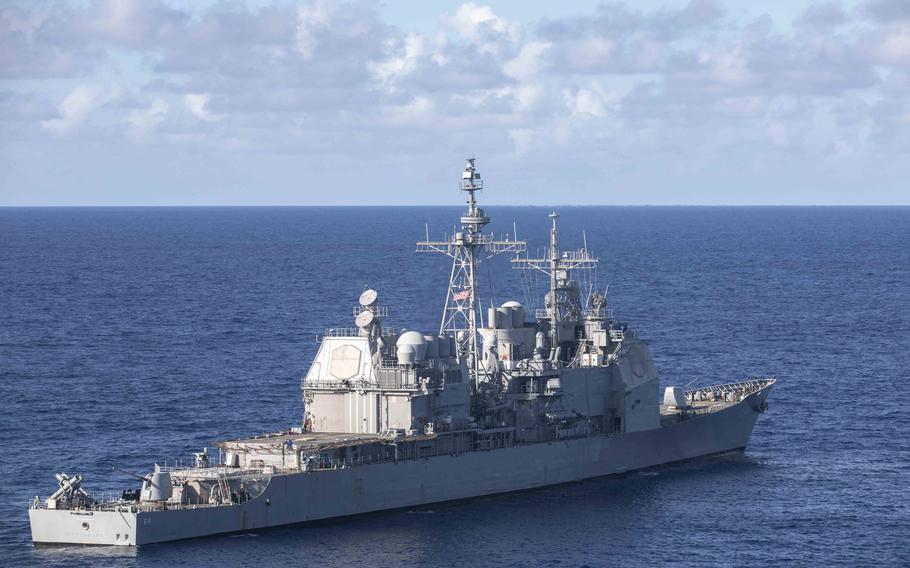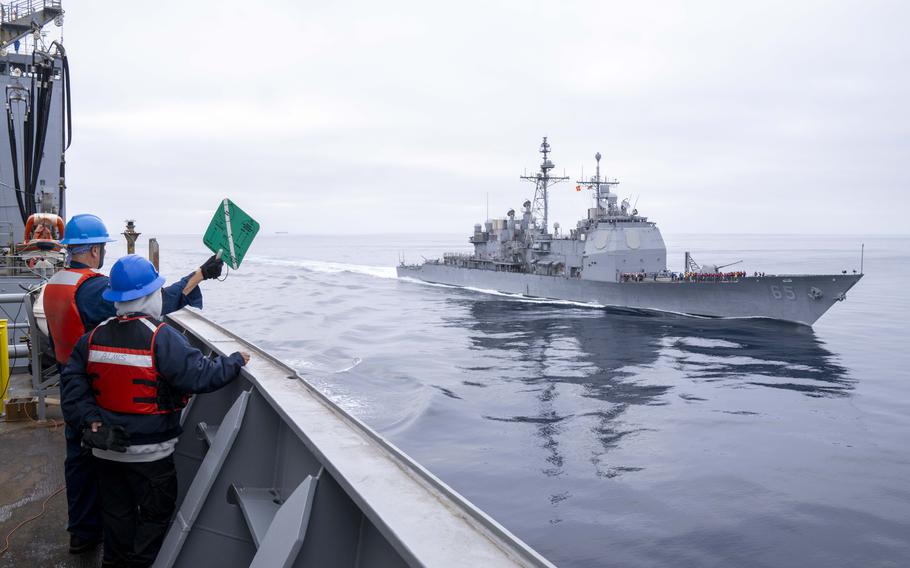
Three Ticonderoga-class guided-missile cruisers that would have been retired from the Navy in 2026, including the USS Gettysburg, will now serve in the fleet for another three years. (Kaitlin Young/U.S. Navy)
WASHINGTON — The Navy is extending the service life of three guided-missile cruisers that would have been retired in 2026, keeping the Ticonderoga-class ships in the fleet for another three years.
The service has been phasing out the Cold War-era Ticonderoga class, retiring four cruisers in 2024 with plans to retire the remaining nine by 2027. But the USS Gettysburg, USS Chosin and USS Cape St. George will now operate through 2029, the Navy said Monday.
Ticonderoga cruisers were intended to have a service life of 30 years but were pushed to 35 years to allow more time for the Navy to replace the more than one dozen warships before taking them out of the water. The Gettysburg, Chosin and Cape St. George, which were commissioned in 1991, will now see 38 years of service before retirement.
“As a former cruiser sailor, I know the incredible value these highly capable warships bring to the fleet, and I am proud of their many decades of service,” Navy Secretary Carlos Del Toro said.
The cruisers are armed with vertical launch missiles, Tomahawk missiles, and six MK-46 torpedoes. Some have been outfitted with ballistic missile defense capabilities. The cruisers are designed for anti-air, undersea and surface warfare, according to the Navy.
The announcement came five days after the Navy extended the service life of 12 aging destroyers that would have begun to retire in 2028 as the sea service balances the need to keep ships at sea with the time that it takes for new ships to join the fleet.
Multiple conflicts around the world are driving the need for more warships. The Navy has been forced to shuffle assets, pulling aircraft carriers supported by guided-missile destroyers from the Indo-Pacific region to deter conflict in the Middle East.

Civilian mariners aboard Military Sealift Command’s Lewis and Clark-class dry cargo and ammunition ship USNS Washington Chambers signal to Ticonderoga-class cruiser USS Chosin as it pulls alongside off the coast of San Diego on Oct. 9, 2024. (Eric Osborne/U.S. Navy)
The extension of the cruisers and destroyers is also part of the Navy’s plan to ready the fleet in the next three years for a possible war with China. The extensions also address criticism from lawmakers in recent years that the sea service was decommissioning ships faster than new ships were joining the fleet.
“The chairman of the People’s Republic of China has told his forces to be ready for war by 2027 — we will be more ready,” top Adm. Lisa Franchetti said in her 2024 Navigation Plan, a framework of her priorities during her tenure as chief of naval operations.
But a decadelong effort to modernize the cruisers to push their service life into the 2030s proved to be more expensive than the Navy expected. The modernization efforts were running about 200% above the estimated costs and were hundreds of days behind schedule, the U.S. Naval Institute reported in 2022. In the case of the USS Vicksburg, the Navy spent approximately $300 million to modernize the cruiser before halting the overhaul and opting to decommission the ship in June.
The Gettysburg, Chosin and Cape St. George have undergone extensive overhauls to modernize their mechanical, engineering and combat systems. The Gettysburg and Chosin completed their modernization in 2023 and 2024, respectively. The Cape St. George is scheduled to complete its modernization in 2025.
“After learning hard lessons from the cruiser modernization program, we are only extending ships that have completed modernization and have the material readiness needed to continue advancing our Navy’s mission,” Del Toro said.
The Gettysburg deployed in September from Naval Station Norfolk, Va., with the USS Harry S. Truman carrier strike group, a scheduled mission that is expected to take the warships to the Middle East where they will defend against Iranian-proxy drone and missile attacks. The Chosin, based in San Diego, participated in October in the Navy’s first attempt to resupply a warship’s weapons system at sea.